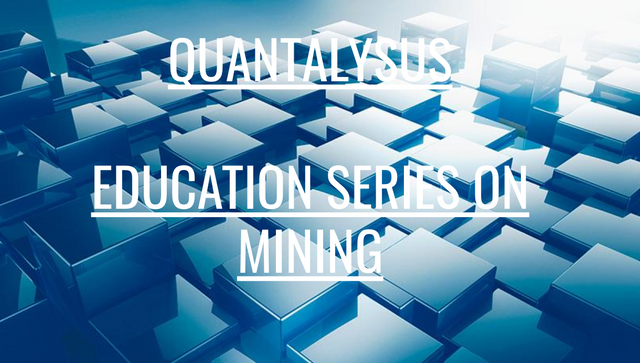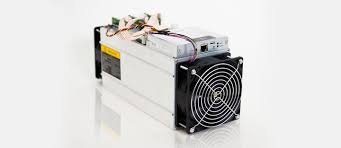Education Series: Mining Hardware

Crypto assets such as cryptocurrencies are created and transacted on networks with varying levels of decentralization. Arguably the most decentralized is Bitcoin (history of Bitcoin), the first cryptocurrency. Decentralized networks do not have a single authority in charge of the network. The network's software is run by individual nodes across the world. Depending on which network you are referring to (i.e. Bitcoin, Ethereum), these nodes play distinct roles in the operations of the protocol. In Bitcoin, the purpose of these nodes is to validate groups of transactions placed together in "blocks". When a block is validated by one node and verified by the rest of the network it is then "mined" and added to the previously chained blocks.
Now that you understand the basics, let's start double clicking in to define the concept. Mining's primary purpose is to secure the network by providing all nodes the incentive to be honest. Miners have a stake in the network and receive a reward validating transactions faithfully. Everyone profits from their honest participation. From the people spending transactions knowing their purchase will go through to the recipients feeling secure they will receive their due, miners provide a beneficial service to all.
CPUs vs GPUs
The appropriate equipment is needed in order to mine cryptocurrencies. When Bitcoin first started miners could use CPUs to mine Bitcoin (up to 100 coins a day in the early days). That quickly changed as miners shifted to GPUs and ultimately to ASICs to gain stronger advantages. CPU stands for the Central Processing Unit. The most popular CPUs are produced primarily by Intel and the second largest provider is AMD. Think of CPUs as the brain since it runs most operations of a computer. CPUs are great for generalist tasks because they are able to efficiently and quickly switch between different computer tasks. This agility allows you to run and toggle between several different applications on your computer.

Intel's Core i5 chip in my MacBook Pro
As the interest level grew in mining Bitcoin, miners started to figure out how to mine more effectively. Rather than use CPUs, they turned to GPUs since solving the Proof-of-Work algorithm in the Bitcoin network was repetitive in nature. The agility that CPUs offered were actually a disadvantage to specific tasks. GPUs are more flexible than ASICs but less flexible than CPUs. Originally designed to processing graphics, miners realized GPUs were more powerful for competitive tasks (rendering is quite repetitive). This ability to focus on few tasks at higher levels of power made GPUs a more attractive chip to mine certain cryptocurrencies with. Companies who produced GPUs such as AMD and Nvidia have recently seen the price for their products increase dramatically. Gamers who once were the largest segment of GPUs are now facing a massive shortage for the key ingredient to their gaming rigs.ASICS
In the search for more power and specificity in chips, miners turned to ASICs (Application Specific Integrated Circuit). IIRC ASIC miner was the first to use ASICs for mining where microchip was specifically designed to execute the Bitcoin hashing algorithm. To give you a perspective of how much more hash power ASICs have, the Bitmain AntMiner S9 features 13.5 tera hash per second (Th/s). The CPU on my MacBook Pro is an Intel Core i5 CPU with a hash rate of 5.1 Mh/s. For comparison:
- 1 kH/s is 1,000 (one thousand) hashes per second.
- 1 MH/s is 1,000,000 (one million) hashes per second.
- 1 GH/s is 1,000,000,000 (one billion) hashes per second.
- 1 TH/s is 1,000,000,000,000 (one trillion) hashes per second.
- 1 PH/s is 1,000,000,000,000,000 (one quadrillion) hashes per second.

Bitmain's AntMiner s9
Powerful companies and groups configure racks of ASIC miners due to their ability to purchase large quantities and configure these mining farms efficiently. One fair criticism of this is that seemingly decentralized networks such as Bitcoin tend to centralize over time. With so much power in the hands of these mining farms, the risk of a 51% attack on a network become more real.In the next series Mining series I will go over network hashrate, ASIC resistance, mining farms, and mining profitability. Hope you learned the basic and high level overview of mining. Thanks for reading as always.
Quantalysus publishes blockchain research and analysis for the crypto community. Please follow on Twitter, Steem (please follow and upvote if you can – thanks!), Telegram channel (New!), and Medium to stay up to date.
My ICO rankings (anything above a 60 by the way I would seriously considering investing in… call me a harsh grader)
If you learned something:
- Please consider donating to keep this website up and running
- Earn Aelf tokens by following them on Twitter (my referral link)
- Follow me on Steem (@quantalysus). I appreciate upvotes!
- Follow me on Twitter (@CryptoQuantalys)
- Education Series: Why we need Bitcoin
- Education Series: The History of Bitcoin
- Education Series: How do ICOs work
- Education Series: Hash Functions
- Education Series: Sybil Attacks
- Education Series: Airdrops
- Education Series: Byzantine General’s Problem
- Education Series: Regulation A and D
- ICO Review: Choon
- ICO Review: Emotiq
- ICO Review: Bit.Game
- ICO Review: ANKR Network
- ICO Review: COTI
- ICO Review: Taraxa (Part 1)
- ICO Review: Arweave
- ICO Review: Lightstreams
- ICO Review: Hypernet
- ICO Review: Hero Node
- ICO Review: Solana
- ICO Review: Phantasma
- ICO Review: Holochain
- ICO Review: Edenchain
- ICO Review: Quarkchain
- ICO Review: DAOStack
- ICO Review: Alchemint
- ICO Review: Loki Network
- Coin Review: Nexo
- Coin Review: Ontology
- Coin Review: Aelf
- Coin Review: Mithril
- Coin Review: Qtum
- Coin Review: Waves
- Coin Review: Banyan Network (BBN)
- Opinion: Token economics
- Opinion: ICO paradox
- Opinion: Why we love Steem
- Analysis: Starkware Industries
- Analysis: If Steem were a country, it would be the most unequal society
Great article! Education is mandatory in crypto.
Upvoted:)
Thanks for reading :)
You've broken the mining hardware information so well and in an easy to understand way. I'm more informed now.
Glad to be of help!
excellent information
You got a 66.44% upvote from @upmewhale courtesy of @quantalysus!
Earn 100% earning payout by delegating SP to @upmewhale. Visit http://www.upmewhale.com for details!
Hello, everyone and @quantalysus! I've created a new Steemit t-shirt and I think that it's better than my previous one! I hope that you'll enjoy my work as well. You may order it here:
.jpg)
https://teespring.com/welcome-to-steemit-t-shirt
Yes, i do hope i really look into it when bitcoin just started. Hesitated and slow now.
Great info. Upvoted. Resteemed. Why is the 51%?
Miners could hack or more people make more mistakes?
With so much power in the hands of these mining farms, the risk of a 51% attack on a network become more real.
Thanks
Joy
Agreed. There is an article Jimmy Song wrote on Medium outlining why he believes this is not as high a risk as one would think.
@resteemator is a new bot casting votes for its followers. Follow @resteemator and vote this comment to increase your chance to be voted in the future!
Mining has become very difficult to buy